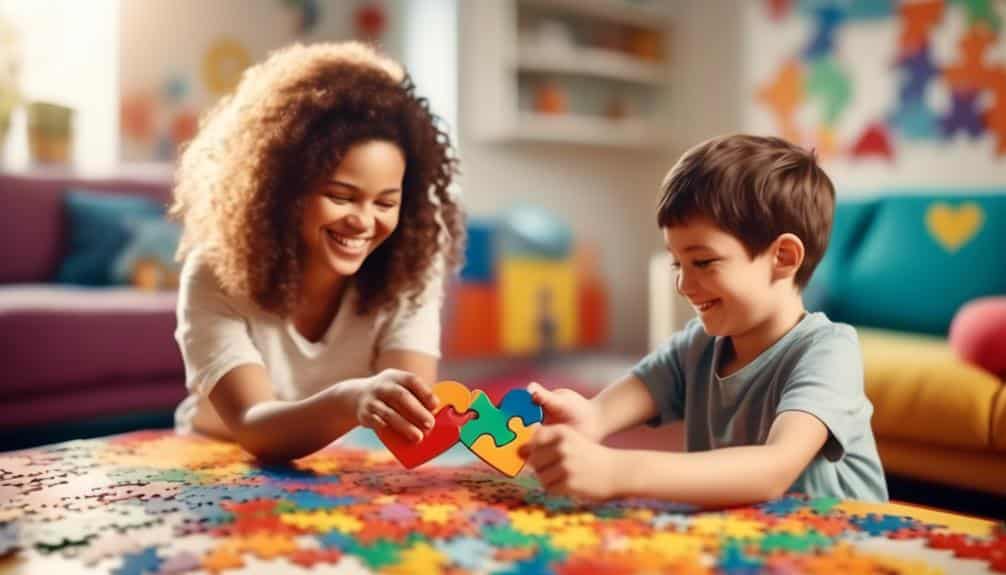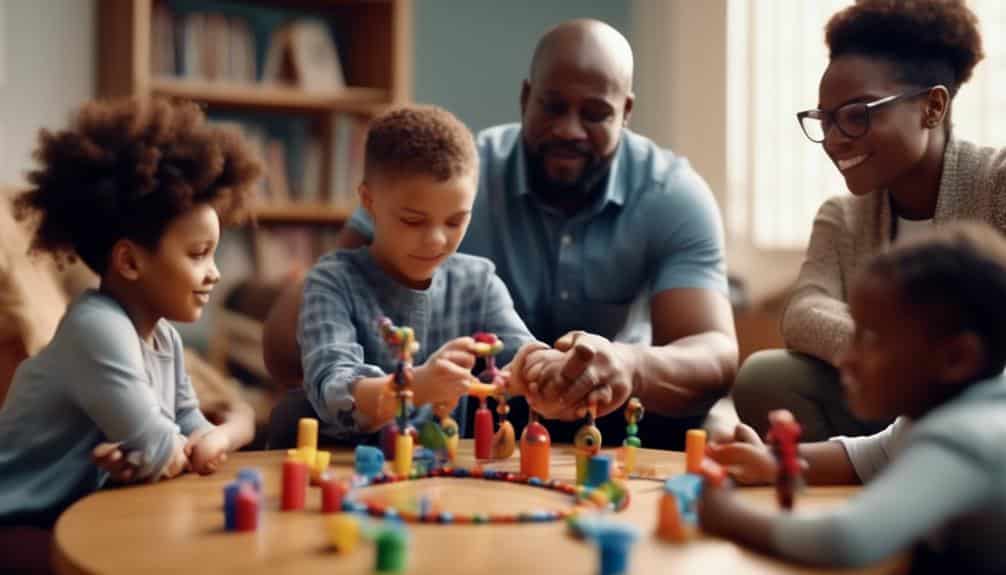Embark on a journey into the world of DIRFloortime and Autism, where the Developmental, Individual Difference, Relationship-based (DIR) model, spearheaded by luminaries like Stanley Greenspan and Serena Wieder, offers a comprehensive approach to nurturing emotional and relational growth in children on the autism spectrum. At its core, DIRFloortime prioritizes meaningful engagements and playful interactions, recognizing their vital role in the holistic development of individuals with autism. Within the therapeutic setting, DIRFloortime therapists leverage a personalized and child-led approach, tailoring interventions to match each child’s unique developmental profiles and individual differences.
Through this approach, therapists aim to facilitate the development of communication abilities, social connections, and emotional capacities, fostering more profound understanding and engagement with the world around them. By integrating DIRFloortime principles into everyday life and routines, families and caregivers become essential partners in the developmental journey, creating supportive environments where children can flourish. Through collaborative efforts and evidence-based interventions,
DIRFloortime addresses core challenges and unlocks the fullest potential of autistic children, enhancing their quality of life and promoting meaningful connections within their communities.
Key Takeaways
- The DIR/Floortime Model is a relationship-based framework for children with autism that prioritizes emotional and relational development.
- The model uses the child’s interests to engage them and incorporates natural play therapy techniques.
- Developmental milestones are tracked, and progress is systematically recorded and evaluated to tailor interventions based on the child’s needs and potential.
- The model recognizes individual differences and adapts to each child’s unique profile, providing personalized play experiences and customized communication methods.
Understanding DIR/Floortime
Delving into the principles of the DIR/Floortime Model, it is imperative to acknowledge its foundation as a nuanced, relationship-based framework that fosters the cognitive, emotional, and social growth of children with autism through responsive and tailored interactions. Conceived by Dr. Stanley Greenspan and Serena Wieder, the DIR/Floortime™ Intervention Program is structured around the pivotal role of emotional experiences in the development of children with ASD.
Floortime therapy stresses the importance of harnessing a child’s interests to promote engagement, thereby enhancing the child’s capacity for emotional regulation and two-way communication. As an early intervention strategy, it builds upon natural play therapy techniques to strengthen foundational social and communication development. Parents and caregivers must observe and follow the child’s cues, creating meaningful and developmentally appropriate interactions.
The interdisciplinary Council on Developmental and Learning Disorders has endorsed DIR/Floortime as an approach that is not one-size-fits-all but highly individualized, considering the intricate interplay between a child’s unique biological and psychological makeup and their environment. This empathetic, child-centric philosophy underpins a therapeutic journey as diverse and dynamic as the spectrum.
Key Developmental Milestones

As we focus on critical developmental milestones, we must recognize their role as benchmarks of a child’s growth in various domains. The Milestone Identification Guide serves as a structured framework for professionals and caregivers to detect and understand the pace and pattern of a child’s development, particularly in autism. Progress Tracking Essentials provide a means to systematically record and evaluate each child’s unique journey, facilitating tailored interventions that align with their developmental needs and potential.
Milestone Identification Guide
Monitoring key developmental milestones is fundamental to assessing a child’s growth and identifying any early signs of developmental delays or autism spectrum disorders. The Milestone Identification Guide is an indispensable tool in the DIR/Floortime method, supporting the Intervention Program for Preschool children by emphasizing:
- Social Skills: Tracking the emergence of joint attention, peer interactions, and responsiveness to social cues.
- Communication Skills: Observing how children express needs and desires, understand language, and begin conversational exchanges.
- Emotional Development: Noting the ability to regulate emotions, display empathy, and adapt to changes in routine.
- Play Therapy Integration involves assessing the developmental level of play, including the use of imagination and the ability to engage in symbolic play.
We can tailor our approach to each child’s unique abilities and challenges by compassionately observing these developmental milestones.
Progress Tracking Essentials
Within autism intervention, meticulous progress tracking of critical developmental milestones—encompassing social communication, emotional regulation, sensory processing, and cognitive growth—is indispensable for evaluating a child’s advancement and refining therapeutic approaches. By consistently documenting and analyzing the benchmarks achieved during Floortime play, therapists can customize therapy for autistic individuals, ensuring it aligns with the child’s interests and targets developmental delays. Play therapy helps foster meaningful engagement and promotes a trajectory toward positive outcomes. For children with autism spectrum disorders, progress tracking essentials not only spotlight the efficacy of the intervention but also guide the ongoing adaptation of strategies to bolster autism intervention success. It’s a compassionate and empirical approach to nurturing each child’s unique developmental journey.
Recognizing Individual Differences

Here are four critical components of recognizing individual differences in the DIR/Floortime Model:
- Personalized Play: Designing play experiences that align with the child’s interests, enabling them to express themselves and engage more meaningfully.
- Customized Communication: This approach focuses on enhancing communication skills by using methods that resonate with the child’s way of processing and responding to the world.
- Emotionally Attuned Interactions: Craft therapy sessions are sensitive to the child’s emotional needs and developmental level, building trust and security.
- Developmental Milestone Mapping: Observing and documenting the child’s unique developmental trajectory to celebrate their achievements and identify areas needing support.
In essence, by respecting and incorporating individual differences into the therapy process, the DIR/Floortime Model enriches the lives of children with autism, helping them to realize their full potential within a compassionate and understanding framework.
Fostering Emotional Connections

Recognizing Emotional Cues
Recognizing and interpreting emotional cues is a foundational component in developing meaningful connections with children diagnosed with autism spectrum disorder. In the context of Autism Spectrum Disorders, Floortime sessions provide a unique opportunity to enhance these emotional connections through tailored interventions. Here are four key strategies:
- Observe and identify the child’s non-verbal emotional expressions, such as facial expressions, body language, and vocal tones.
- Please respond to the child’s emotional signals with empathy, understanding, and accepting their feelings.
- Foster an environment where the child feels safe to express emotions, which is crucial for their emotional and social development.
- Use play-based activities to encourage the child to communicate their emotional state, supporting their ability to develop richer emotional communication.
These steps help autistic children develop the necessary skills to engage socially and emotionally, forming stronger bonds and promoting overall well-being.
Encouraging Expressive Communication
Building upon the foundation of recognizing emotional cues and encouraging expressive communication in children with autism involves creating interactive and sensory-appropriate environments that facilitate a deeper emotional connection. Inspired by Stanley Greenspan’s approach, Play Therapy for Children emphasizes the importance of tuning into a child’s dynamic rhythm. Tailoring environments to each child’s preferences bolsters their ability to engage and express their needs. By following the child’s lead in play, caregivers encourage skills and emotional growth. The child’s play becomes a dialogue, enhancing creative thinking and verbal skills. Consistent, patient efforts to engage the child in such a supportive atmosphere can significantly impact their capacity to connect and communicate, grounding therapy in compassion and understanding.
Building Trusting Relationships
Establishing trusting relationships through Dirfloortime techniques hinges on the caregiver’s ability to engage in interactive play that resonates with the child’s unique interests, laying the groundwork for deep emotional connections.
To support this goal, the following strategies are crucial:
- Engage in Play: Use the child’s natural interests to fuel interactive play sessions, which is essential for young autistic children to form secure emotional bonds.
- Follow the Lead: Allowing the child to lead the interaction can help autistic children feel understood and supported, fostering trust.
- Daily Integration: Consistently incorporate the approach into daily routines to help children build emotional connections within a familiar context.
- Reflective Interaction: Be present and responsive, matching the child’s emotional states, to strengthen the intervention approach and promote pivotal responses that underpin Developmental and Learning Disorders therapy.
Enhancing Communication Skills

In the realm of autism interventions, it is crucial to recognize that children with developmental delays, including those with autism, may experience the world differently. The Dirfloortime strategy respects these differences and encourages the expansion of communication abilities within a child’s comfort zone. This personalized method contrasts with more structured techniques like applied behavior analysis. Yet, it can seamlessly blend with a comprehensive treatment plan that includes Activities of Daily Living and fostering positive behaviors.
Parental involvement is indispensable in reinforcing the gains made during therapy. Collaborative efforts ensure that the strategies employed during Dirfloortime sessions are consistent and effective across various settings, which is particularly beneficial for Preschool Children with Autism. By focusing on the child’s intrinsic motivations and interests, Dirfloortime facilitates meaningful exchanges that enhance communication and social interaction, critical components of a child’s ongoing development and overall success in autism intervention.
Building Healthy Relationships

While enhancing communication skills is vital to autism intervention, Dirfloortime’s role is equally important in fostering healthy relationships through attuned interactions, and emotionally meaningful play is equally important. This approach is central to the Program for Preschool Children, where parents can provide nurturing and growth-promoting experiences.
Here are some fundamental techniques used in Dirfloortime to build healthy relationships:
- Attuned Emotional Interactions: Parents are encouraged to attune to their child’s emotional cues. Understanding their child’s unique needs and responses is crucial for parents to foster a secure and trusting bond.
- Meaningful Play Sessions: Engaging in play that the child, parents, and therapists direct helps children express their feelings and ideas, which is a foundation for developing emotional skills.
- Supportive Environment: It is essential to create a warm and accepting atmosphere where autistic individuals feel safe. This setting allows for the expression of self and promotes the strengthening of relationships.
- Routine and Consistency: Establishing predictable patterns within the home can alleviate some core autism challenges. Consistency helps children know what to expect, reducing anxiety and enhancing their ability to engage and connect.
Implementing these techniques with compassion and understanding can lead to profound growth in social-emotional capacities, helping parents support children as they learn and thrive.
Structuring the Environment

A well-structured intervention environment can help autistic children develop meaningful interactions and enhance their motor skills within their natural environments. Occupational Therapy in Pediatrics often emphasizes the importance of personalized learning environments promoting growth and development.
Incorporating Sensory Processing strategies into a child’s daily life is vital to creating a supportive atmosphere. Ensuring that the physical space is conducive to a child’s sensory preferences can alleviate discomfort and help them engage more fully in therapeutic activities. Here’s a visual representation of ideas for structuring the environment:
| Element | Purpose | Example |
|---|---|---|
| Predictable Routine | To provide stability and security | Set meal and playtimes |
| Sensory-Friendly Area | To reduce sensory overwhelm | A quiet corner with soft lighting |
| Floortime Integration | To encourage naturalistic learning | Use mealtimes for engagement |
| Professional Input | To tailor the environment to individual | Advice from an occupational therapist |
This compassionate approach to Autism Treatment ensures that each child’s needs are met, fostering an atmosphere where they can thrive.
Integrating Daily Activities

- Utilize mealtimes as a chance for the child to participate in social interaction and communication, turning a necessary part of the day into a therapeutic session.
- Designate a specific play area within the home and community settings where the child feels comfortable to explore and engage, ensuring consistency and security.
- Incorporate outdoor play into therapy sessions, stimulating sensory integration and encouraging a child’s curiosity and relationship-building.
- Collaborate with professionals to create a seamless transition of strategies from formal therapy sessions to the home environment, thereby increasing the intervention’s effect size.
Guidance from therapists trained in DIR/Floortime is crucial in tailoring these strategies, as highlighted in “Autism: A Systematic Review” and “Spectrum Disorders: Preliminary Findings,” to fit the unique needs of each child and to foster progress in their developmental journey.
Collaborative Team Approach

The strength of the Collaborative Team Approach lies in its recognition that each child becomes the central focus of a network that focuses on helping them develop to their fullest potential. Support Groups are often a key element, providing a forum for parents and caregivers to share experiences and strategies.
Frequently Asked Questions
What are the most effective benefits when combining DIRFloortime and Autism intervention?
The most effective intervention for autism varies per individual. It requires a tailored approach considering the child’s needs, strengths, and preferences. This approach often incorporates behavioral, educational, and developmental strategies with family involvement.
How Effective Is DIR/Floortime for Autism?
Floortime therapy has demonstrated effectiveness in improving engagement, communication, and emotional development in children with autism. It is a valuable intervention that supports individual needs and family involvement.
What Is the Most Promising Approach to the Treatment of Autistic Spectrum Disorder?
The treatment landscape for autism spectrum disorder is diverse. Still, personalized, evidence-based interventions, such as behavioral therapies tailored to individual needs, consistently show promise in enhancing communication, social skills, and overall quality of life.
What Aspects are the Most Effective Areas of DIRFloortime for Autism?
The most effective treatment for autism utilizes the DIR/Floortime Model, focusing on individualized therapeutic strategies that foster social, emotional, and cognitive development through relationship-based play and communication tailored to the child’s unique developmental profile.
Conclusion
The DIRFloortime model is a comprehensive, relationship-based therapy designed to support the development of individuals with autism spectrum disorders. Dr. Stanley Greenspan and Serena Wieder developed this holistic approach, emphasizing the importance of engagement, regulation, and social interactions in promoting cognitive, emotional, and social development. The DIRFloortime model uses play-based activities and meaningful interactions to address the core challenges faced by children with autism spectrum disorders, including sensory sensitivities, developmental delays, and difficulties with communication and social skills.
Occupational therapists, speech therapists, and other professionals use the DIRFloortime model to provide an individualized approach to therapy that considers each child’s unique developmental profile. By focusing on the child’s emotional and intellectual growth, the DIRFloortime model aims to help children with autism spectrum disorders reach their fullest potential. Therapy sessions are designed to promote reciprocal interactions and support the child’s developmental trajectory, focusing on building meaningful relationships and promoting skill development in all developmental domains.
A solid evidence base supports the DIRFloortime model and is effective in promoting emotional and social development in individuals with autism spectrum disorders. With its focus on relationship-based therapy, Child-Led Play, and other vital components, the DIRFloortime model provides a supportive environment for children with autism spectrum disorders to thrive. If you are looking for an effective and patient-centered approach to autism therapy, the DIRFloortime model may be the right choice for you and your family.


Recent Comments